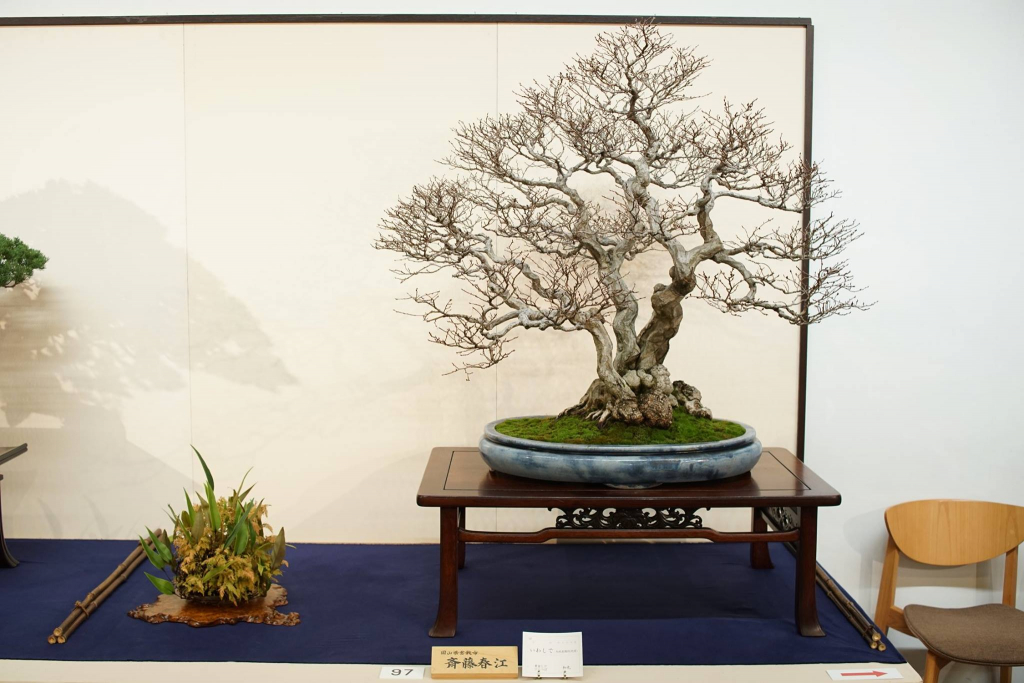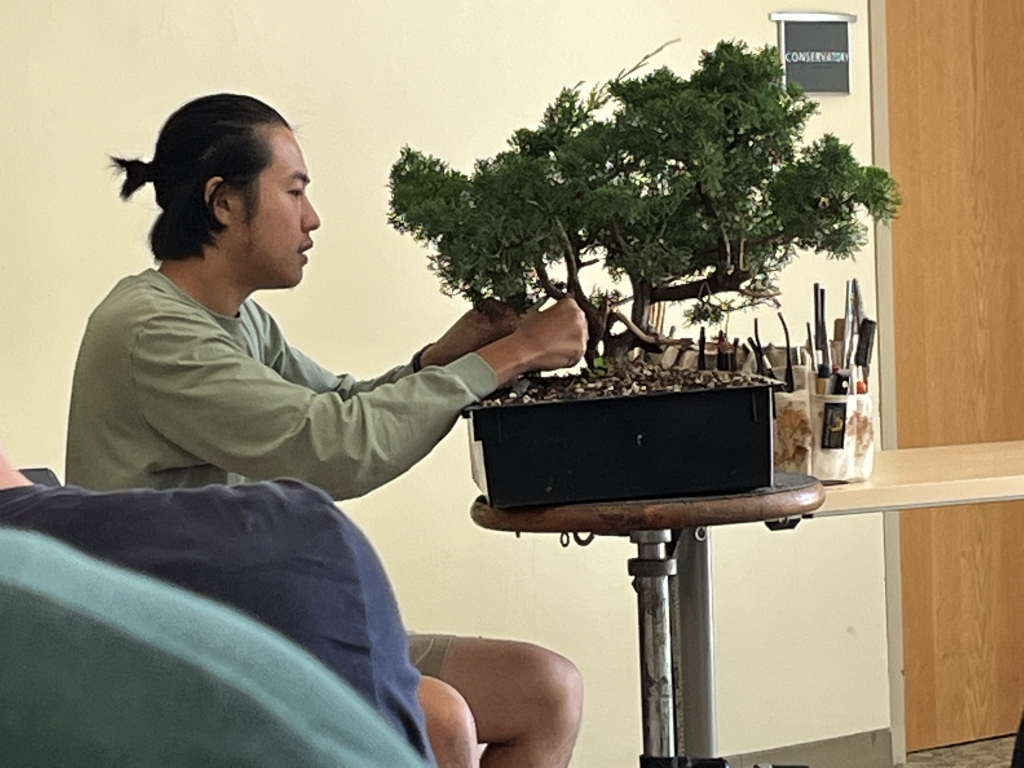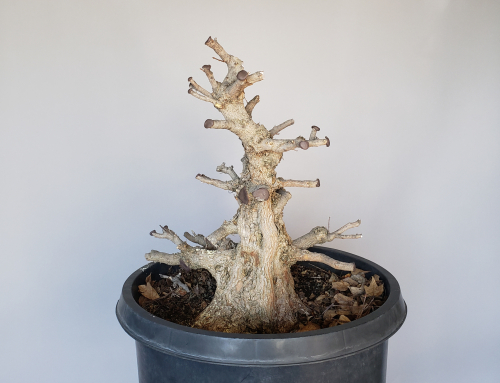I thank my family, supporters, and my customers in bonsai who help enable my pursuit and passion of this art. In 2018 I made the decision to pursue an apprenticeship at Fujikawa Kouka-en, in Osaka Japan. Regrettably, after 2 years from unforeseen conflicts and my own maturity at that time I chose to return to the US. I returned to the corporate work force, employed as an engineer for a medical device start up while I continued my bonsai pursuits semi-professionally for a small clientele base in central and southern California. I thank professionals, Peter Tea and John Wang, who were resources to provide some mentorship as well as to continuously further my knowledge/skills during this time.
After much contention and indecision, as well as the pathological obsession that bonsai is to me I’ve once again taken the plunge and chose to pursue bonsai as my full time career. Coincidingly with this decision, I had prior a week of work booked with the Iowa Bonsai Association. It was my first gig outside of California so I was quite nervous as to whether I could deliver to expectations, but it could not have went any better. I thank the hospitality of my host, Scott Allen and his wife Jenn, and the IBA club which was great to work with. I did a few private days, a workshop, 3 demos/talks at the Des Moines Botanical Gardens, followed by judging of the annual show held at the Iowa state fair.
Following my week work I received so much positive feedback from all the members as well as plans for repeat booking and piggybacking adjacent states that I have at least some sense of confidence that I’m headed in the right direction. Thank you Susan Daufeldt for providing some of the workshop and demo photos. One member sent me a testimonial to share which I will include at the end of this post.
It has been my emphasis in my teaching style to be very explicit on why we do things, what we expect out of the work, and the long term implication of the techniques/work applied. Both in my private days, demos, workshops, and judging the overarching basis of my work can be broken into 2 criteria:
- Will the work applied improve the tree can can it be continued and built upon in the future?
- Will the work capture and show a history of “age in cultivation”
From my time in Japan I’ve noticed a distinction when professionals say a tree is old. Age is not only implying the age of the tree, although this may be part of the case especially intrinsic to collected yamadori, but often age is referring to age in cultivation. For example, consider a deciduous tree which over 10, 20, 50 years has had branches meticulously maintained and a dense silhouette create from thin (and old!) branches.


At immediate glance we can not only tell that the trees are old, but that it’s time cultivated as a bonsai is long too! The branches carry a sense of time giving more presence and impact to the tree. This is also why we show deciduous trees in winter silhouette–to show off the branches that were so meticulously developed over many years.
Of course this applies to coniferous material as well, but will have some species specific characteristic in terms of the branch density, coarseness, as well as stylistic intentions of the professional.


I say this to imply that when we work on our trees, we want to most efficiently use our time so our trees and can continuously progress and improve. In this era of exciting collected yamadori it is quite achievable to rapidly set an aesthetic and full silhouette, but if the work done needs to be reset every 2-5 years, then even if we worked on that tree for 25 years its age as a bonsai, or age in cultivation will forever be stuck at that 2-5 year mark! Of course this is not an attempt to claim superiority, as I am very much continuously learning and improving my skills, but is something we all can consider and keep in the back of our minds as we work on our trees.
That said, now into the work. Iowa is a temperate climate with very cold winters and hot humid summers. The season is comparatively short say to Southern California so in doing work we should consider the current season as well as remaining time left the tree can respond to a given technique. When we enter the peak temperatures of summers, roots will enter a “summer dormancy” which counter-intuitively means the tree is taking in less water with rising temperatures. With reduced transpiration and sap flow, trees are less rapidly able to move water and heal damage. Meaning at this time (mid August) for Iowa is not ideal for heavy bending and hard work.
As for deciduous there is about 1-1.5 months of warm weather left for trees to grow–cutting it very close say for deciduous defoliation or heavy cut backs which will encourage a soft successive flush. Ideally this work would of had been done in July to start of August at latest, so deciduous work was restricted to general cut backs, partial defoliation to prevent further weakening of interior shoots (not enough removal of foliage to generate a secondary flush), and only more significant work on very strong trees that seemed apt to rapidly produce another flush before the end of the season.
For the most part work was on conifers–junipers which are completely lignified at this time, some yews, and ponderosa which were the notable species. I was not able to get photos of everything done but here is a collection of some over the week.
Shohin kishu, back turned into front (sorry I do not have original front)



Here is an interesting windswept, penjing-esk juniper. We contemplated lifting the angle up and making a more bunjin, informal upright style but ended up going with a more unconventional look. The tree previously had spider mites last year but the current growth otherwise seemed healthy enough to be worked on.


Here is an old Korean hornbeam planted in a very nice Horst pot. A few things to note. The tree suffered some leaf burn–many IBA members mentioned that this year was an uncharacteristically hot and low precipitation season. The inner canopy has been neglected resulting in some dieback. If the tree was vigorous enough and it was a month earlier in the season, I would completely defoliate the outer canopy, only leaving interior branches and some weak branches alone. We ended up cutting back extensions on stronger regions, and partial defoliating (removing 1 leaf of each alternating outer pair) to enable more light on interior foliage.


Refinement work on another telperion juniper that Bjorn did the initial styling on several years back. It has since become overgrown with many branches that are too thick. I did a significant cut back, some thinning, and wired out the tree. It should be allowed to grow and fill in. We can do more detail wiring next season to get better pad definition.


Some workshop shots:





A big yew brought and worked on by Dan Morton


I did 3 demos and talks to both bonsai enthusiasts and the general public at the Des Moines Botanical Gardens. I talked a lot about my bonsai philosophy, some stories from my apprenticeship in Japan, and of course the trees on hand. Club members brought several trees I could select from and pick for the demonstrations. I looked for trees that were 1) healthy and 2) would tolerate demonstration type work that would not infringe on my previous criteria mentioned earlier.
Common juniper, wiring out branches and setting some pad structure. I wanted a steeper angle for the tree but just worked with the available blocks.

Telperion farms field grown kishu. Discussed approach and methodology for establishing a style or design. Ended up making a multi-trunked clump type composition.


Another taxus brought by Dan Morton. I believe he mentioned these were collected from the old Ford factory in the 80s.

Some of the results:


Lastly was the Iowa Bonsai Show held at the state fair. Coming from California, I had no idea that state fairs were a huge deal in the midwest. Hundreds of thousands of people present at a given time and a lot going on. The quality of the show was mixed, and I judged the trees and did a critique. Main criteria was trees showing age in cultivation, then considerations to style, pot/stand combination, and display. I did not take very many pictures of the show. It was hard to judge in that I would say there were not any singular outstanding trees from the rest but in comparable quality brackets. Definitely some nice conifers but felt “young” as bonsai and trees which if they were worked on more or had a bit more refinement/development I would have allocated awards differently.





Butter cow…



All in all it was a great week of work and I enjoyed the friendliness and hospitality of those I met.


For those that made it to the end of my post, I am booking my 2023 calendar and I still have some openings left for this year. I am eager to work, so if you are interested in any of my services, please contact me at julian.tsai96@gmail.com or through my website: here.
Here is the testimonial sent to me by Dan Morton about my work in Iowa:
I recently attended a workshop sponsored by our local club , a young man I’d never heard of , so I checked out a few of his videos and thought I’d give him a challenge , a rough collected Yew I had dug up in the late 80s and just put it in a grow pot this year , many have seen it and made suggestions on it’s style , but there was something missing so I rented a cargo van and loaded it up , after 6 hours of work I was pleasantly surprised with the outcome , the lines that was created by showing the trunk , the Shari that was carved , so impressed with his style and knowledge that I took another to a demo hoping to get it worked on (the smaller one) and he choose the small one . As he was working with me he explained the reasons why he was doing what he was doing , but he explain that this this is what to expect in 3 to 5 years , what to do and how to achieve it . I was so impressed with his knowledge of this species that I had him sign and date the metal tags to stay with them forever , I hope our club can get him back again next year to continue his work . I speak for all the students that were at the workshop ,the demos had a total of 84 visitors for the 3 trees , this was open to the public , I don’t recall anyone leaving once he started styling a tree , those that had there tree chosen for the demo was quite pleased .
Dan





I really like the narrative Julian, it makes the current work/styling and the trees future really make sense. I’ll look forward to future posts.
Thank you Michael! I’m trying to get back in the rhythm of writing again